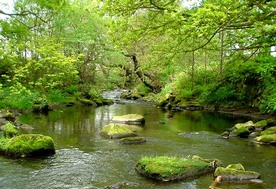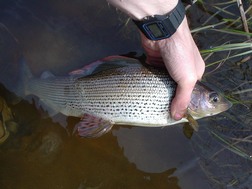

Biodiversity
Action
Plan
Grayling became extinct in the river Don in the 19th century with the growth of industry creating more polluted waters, silting-up of river beds, and loss of access to spawning gravels. The re-introduction of Grayling has been successful, however maintaining populations at a favourable level in the upper river Don remains a challenge.
Grayling are long, slim-bodied fish with grey-green backs and silver flanks, a white underbelly, black spots across their bodies and red/orange fins. Smaller than Brown Trout, Grayling can be distinguished by their large sail-shaped dorsal fin, the top and rear half of which has a red tint.
Grayling, like Brown Trout, live in unpolluted, fast-flowing, stony and gravelly rivers and streams, and feed on insects and other invertebrates.
The spawning season for Grayling is not the same as Brown Trout and Salmon, as it takes place in April and May rather than the winter months. Grayling spawn in shallower water where there is fine gravel and a moderate current speed.
Grayling will not live in more acidic waters or those that have even the slightest hint of pollution and, acting as a barometer of water quality, are often the first fish to disappear when water quality is degraded. They require well oxygenated waters, either neutral or slightly alkaline, rivers and streams with strong flows and flow diversity, and clean, unsilted gravels in order to spawn. Rivers and streams with diverse habitat features allow Brown Trout and Grayling to coexist.
Grayling face a number of threats including habitat deterioration, more frequent extreme weather events, drought with low water levels, pollution and predation. Heavy rain and runoff from upland moors have a detrimental effect by causing increased acidity levels and washing away of spawning gravels. These threats may be exacerbated by climate changes.
Many of the habitat enhancement and conservation measures for trout will help conserve and enhance Grayling populations. However Brown Trout which is longer lived, may dominate shared waters in summer months.
For further information on distribution, conservation and actions relating to Grayling and other local priority fish species follow the links below.
Grayling Thymallus thymallus
Grayling is not listed as a UKBAP priority species or as a Species of Principal Importance
However Grayling is listed in Annex 2 of the EU Habitats Directive as a species of Europe interest from a conservation point of view.
This means that their exploitation must be compatible with maintaining grayling populations at a favourable conservation status.
Grayling populations are only protected by fishing regulations and conditions set by the Environment Agency.
The conservation of current Grayling populations is important,
Links
Wild Trout Trust Grayling & Trout
Grayling Society Conservation
Associated Habitats
Running water: rivers & streams
Habitat requirements
- Good water quality
- Well-oxygenated water
- Fast-flowing, clear, water with a hard gravel substrate
- Flow-diversity to suit its different life-stages
- Appropriate cover from woody debris, overhanging and aquatic vegetation, etc.
- Abundant supply of insect prey within the water course
Grayling in some UK waters have a relatively short life span of 4-5 years, but other populations are longer lived -up to 9 years; still much shorter than Brown Trout.


Grayling